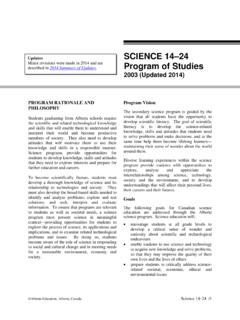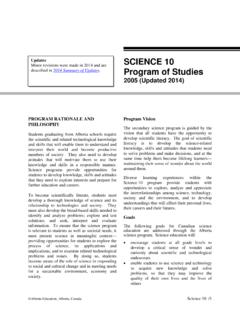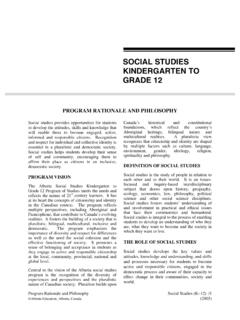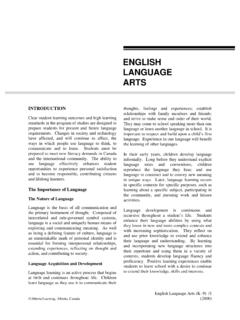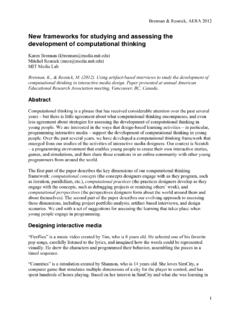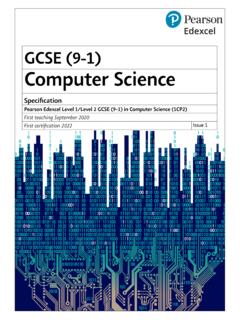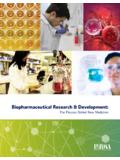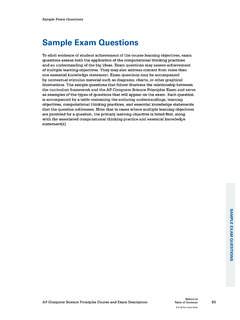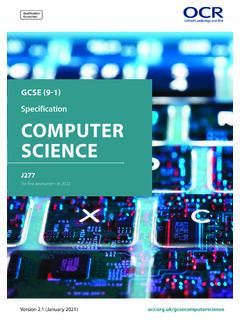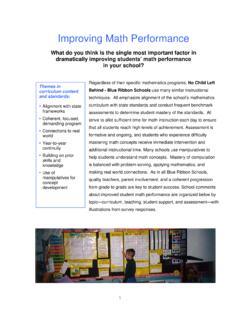Transcription of MATHEMATICS GRADES 10–12 - Alberta
1 MATHEMATICS (10 12) /1 Alberta Education, Alberta , Canada (2008) INTRODUCTION The MATHEMATICS GRADES 10 12 Program of Studies has been derived from The Common Curriculum Framework for GRADES 10 12 MATHEMATICS : Western and Northern Canadian Protocol, January 2008 (the Common Curriculum Framework). The program of studies incorporates the conceptual framework for GRADES 10 12 MATHEMATICS and most of the general outcomes and specific outcomes that were established in the Common Curriculum Framework.
2 (Note: Some of the outcomes for MATHEMATICS 20-2 and 30-2 in this program of studies are different from the outcomes for Foundations of MATHEMATICS in the Common Curriculum Framework.) BACKGROUND The Common Curriculum Framework was developed by seven ministries of education ( Alberta , British Columbia, Manitoba, Northwest Territories, Nunavut, Saskatchewan and Yukon Territory) in collaboration with teachers, administrators, parents, business representatives, post-secondary educators and others. The framework identifies beliefs about MATHEMATICS , general and specific student outcomes, and achievement indicators agreed upon by the seven jurisdictions.
3 BELIEFS ABOUT STUDENTS AND MATHEMATICS LEARNING Students are curious, active learners with individual interests, abilities, needs and career goals. They come to school with varying knowledge, life experiences, expectations and backgrounds. A key component in developing mathematical literacy in students is making connections to these backgrounds, experiences, goals and aspirations. Students construct their understanding of MATHEMATICS by developing meaning based on a variety of learning experiences. This meaning is best developed when learners encounter mathematical experiences that proceed from simple to complex and from the concrete to the abstract.
4 The use of manipulatives, visuals and a variety of pedagogical approaches can address the diversity of learning styles and developmental stages of students. At all levels of understanding, students benefit from working with a variety of materials, tools and contexts when constructing meaning about new mathematical ideas. Meaningful student discussions also provide essential links among concrete, pictorial and symbolic representations of MATHEMATICS . MATHEMATICS GRADES 10 12 2/ MATHEMATICS (10 12) (2008) Alberta Education, Alberta , Canada The learning environment should value, respect and address all students experiences and ways of thinking, so that students are comfortable taking intellectual risks, asking questions and posing conjectures.
5 Students need to explore MATHEMATICS through solving problems in order to continue developing personal strategies and mathematical literacy. It is important to realize that it is acceptable to solve problems in different ways and that solutions may vary depending upon how the problem is understood. FIRST NATIONS, M TIS AND INUIT PERSPECTIVES First Nations, M tis and Inuit students in northern and western Canada come from diverse geographic areas with varied cultural and linguistic backgrounds. Students attend schools in a variety of settings, including urban, rural and isolated communities.
6 Teachers need to understand the diversity of students cultures and experiences. First Nations, M tis and Inuit students often have a holistic view of the environment they look for connections in learning and learn best when MATHEMATICS is contextualized. They may come from cultures where learning takes place through active participation. Traditionally, little emphasis was placed upon the written word, so oral communication and practical applications and experiences are important to student learning and understanding. By understanding and responding to nonverbal cues, teachers can optimize student learning and mathematical understanding.
7 A variety of teaching and assessment strategies help build upon the diverse knowledge, cultures, communication styles, skills, attitudes, experiences and learning styles of students. Research indicates that when strategies go beyond the incidental inclusion of topics and objects unique to a culture or region, greater levels of understanding can be achieved (Banks and Banks, 1993). AFFECTIVE DOMAIN A positive attitude is an important aspect of the affective domain and has a profound effect on learning. Environments that create a sense of belonging, support risk taking and provide opportunities for success help students to develop and maintain positive attitudes and self-confidence.
8 Students with positive attitudes toward learning MATHEMATICS are likely to be motivated and prepared to learn, to participate willingly in classroom activities, to persist in challenging situations and to engage in reflective practices. Teachers, students and parents need to recognize the relationship between the affective and cognitive domains and to nurture those aspects of the affective domain that contribute to positive attitudes. To experience success, students must be taught to set achievable goals and to assess themselves as they work toward these goals. Striving toward success and becoming autonomous and responsible learners are ongoing, reflective processes that involve revisiting the setting and assessing of personal goals.
9 GOALS FOR STUDENTS The main goals of MATHEMATICS education are to prepare students to: solve problems communicate and reason mathematically make connections between MATHEMATICS and its applications become mathematically literate appreciate and value MATHEMATICS make informed decisions as contributors to society. Students who have met these goals: gain an understanding and appreciation of the role of MATHEMATICS in society exhibit a positive attitude toward MATHEMATICS engage and persevere in mathematical problem solving MATHEMATICS (10 12) /3 Alberta Education, Alberta , Canada (2008) contribute to mathematical discussions take risks in performing mathematical tasks exhibit curiosity about MATHEMATICS and situations involving MATHEMATICS .
10 In order to assist students in attaining these goals, teachers are encouraged to develop a classroom atmosphere that fosters conceptual understanding through: taking risks thinking and reflecting independently sharing and communicating mathematical understanding solving problems in individual and group projects pursuing greater understanding of MATHEMATICS appreciating the value of MATHEMATICS throughout history. 4/ MATHEMATICS (10 12) (2008) Alberta Education, Alberta , Canada CONCEPTUAL FRAMEWORK FOR GRADES 10 12 MATHEMATICS The chart below provides an overview of how mathematical processes and the nature of MATHEMATICS influence learning outcomes.
